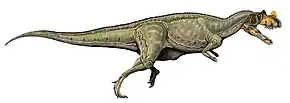| Ilokelesia Temporal range: Cenomanian ~ | |
|---|---|
 | |
| Life restoration | |
| Scientific classification | |
| Domain: | Eukaryota |
| Kingdom: | Animalia |
| Phylum: | Chordata |
| Clade: | Dinosauria |
| Clade: | Saurischia |
| Clade: | Theropoda |
| Family: | †Abelisauridae |
| Genus: | †Ilokelesia Coria & Salgado, 1998 |
| Species: | †I. aguadagrandensis |
| Binomial name | |
| †Ilokelesia aguadagrandensis Coria & Salgado, 1998 | |
Ilokelesia is an extinct genus of abelisaurid theropod,[1] preserved in the layers of the earliest Late Cretaceous[2] of the Huincul Formation, Neuquén Group, located near Plaza Huincul, Neuquén Province, Argentina. The specimen, consisting of very fragmentary elements of the skull and the axial and appendicular skeleton, was described by Rodolfo Coria and Leonardo Salgado in late 1998.[3]
Discovery and naming
Ilokelesia is only known from very fragmentary elements of the skull and the axial and appendicular skeleton, discovered in 1991.[1] It was discovered ten meters away from where the holotype of Huinculsaurus was discovered. The genus was named and described in 1998.[3]
Etymology
The generic name's etymology is derived from the Mapuche language, ilo meaning "flesh" and kelesio, "lizard"; while the specific descriptor reflects the name of the locality where the fossil was found, Aguada Grande.[3]
Description
Ilokelesia was a medium-sized theropod. In 2010 Gregory S. Paul gave a length of 4 meters (13 ft) and a weight of 200 kg (440 lbs).[4] In 2016 it was estimated to be 5.3 metres (17 ft) in length in a comprehensive analysis of abelisaur size.[5] The same year another estimation listed it higher at 5.8 meters (19 ft) and 840 kg (1,850 lbs).[6] It is characterized by features of the skull, namely of the quadrate and postorbital bones. The vertebral series also has distinctive characters setting it apart from other abelisaurs, such as reduced processes on the cervical vertebrae and dorsal vertebrae lacking pleurocoels.[3]
I. aguadagrandensis was considered the most basal abelisaur described at the time, sharing characters, such as an expansion of the postorbital bone above the orbit and a flange of the same bone inside the orbit, with Abelisauridae and Noasauridae; but it was considered to retain primitive features for Abelisauria, such as an opening in the quadrate bone and a T-shaped postorbital.[3] A subsequent analysis has placed it within Abelisauridae, as a brachyrostran carnotaurine.[7]
See also
References
- 1 2 Coria, R.A.; Salgado, L. & Calvo, J.O. (1991) "Primeros restos de dinosaurios Theropoda del Miembro Huincul, Formación Río Limay (Cretácico Tardío Presenoniano), Neuquén, Argentina." Ameghiniana, 28: 405-406.
- ↑ Coria, R.A.; Currie, P.J. & Carabajal, A.P. (2006). "A new abelisauroid theropod from northwestern Patagonia" Canadian Journal of Earth Sciences 43: 1283—1289. doi:101139/E06-25
- 1 2 3 4 5 Coria, Rodolfo A.; Salgado, Leonardo (December 1998). "A Basal Abelisauria Novas, 1992 (Theropoda-Ceratosauria) from the Cretaceous of Patagonia, Argentina" (PDF). Gaia. 15: 89–102.
- ↑ Paul, Gregory S. (2010). The Princeton Field Guide to Dinosaurs. New Jersey: Princeton University Press. p. 78.
- ↑ Grillo, O. N.; Delcourt, R. (2016). "Allometry and body length of abelisauroid theropods: Pycnonemosaurus nevesi is the new king". Cretaceous Research. 69: 71–89. doi:10.1016/j.cretres.2016.09.001.
- ↑ Molina-Pérez & Larramendi (2016). Récords y curiosidades de los dinosaurios Terópodos y otros dinosauromorfos. Barcelona, Spain: Larousse. p. 257. ISBN 9780565094973.
- ↑ Canale, J.I.; Scanferla, C.A.; Agnolin, F. & Novas, F.E. (2009). "New carnivorous dinosaur from the Late Cretaceous of NW Patagonia and the evolution of abelisaurid theropods" (PDF). Naturwissenschaften. 96 (3): 409–414. Bibcode:2009NW.....96..409C. doi:10.1007/s00114-008-0487-4. hdl:11336/52024. PMID 19057888. S2CID 23619863.

.jpg.webp)












